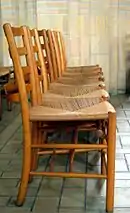Kaare Klint
Kaare Klint (15 December 1888 – 28 March 1954) was a Danish architect and furniture designer, known as the father of modern Danish furniture design. Style was epitomized by clean, pure lines, use of the best materials of his time and superb craftsmanship.
Kaare Klint architect and furniture designer | |
|---|---|
 | |
| Born | 15 December 1888 |
| Died | 28 March 1954 (aged 65) |
| Nationality | Danish |
| Occupation | Architect |
| Awards | C. F. Hansen Medal (1954) |
| Buildings | Bethlehem Church |
He was the son of the equally influential architect Peder Vilhelm Jensen-Klint whose monumental Grundtvig's Church he completed after his father's death in 1930.
Early life and education
Kaare Klint was born on 15 December 1888 in the Frederiksberg district of Copenhagen, the son of Peder Vilhelm Jensen-Klint, then a struggling painter about to abandon his artistic career in place of a more secure career in architecture.
Klint apprenticed as a furniture maker in Kalundborg and Copenhagen from 1893 and took classes at technical school in Copenhagen, Jens Møller-Jensens furniture school, and the Artists' Studio Schools under Johan Rohde. He was then articled to Carl Petersen and was also taught the architectural trade by his father, who had completed his first architectural project in 1896.[1]
Design career
In 1914, Klint designed his first piece of furniture, the Faaborg Chair, for Carl Petersen's Faaborg Museum in 1914. He went on to create furniture and fittings for a number of other museums.
From 1921 to 1926 he was responsible for the conversion of Frederiks Hospital into the Danish Museum of Art & Design together with Thorkild Henningsen and Ivar Bentsen. In 1927 he also created a chair in mahogany for the museum which was inspired by English 18th-century chairs.[2] [3]
Klint's carefully researched furniture designs are based on functionality, proportions adapted to the human body, craftsmanship, and the use of high-quality materials. Notable examples of his work include the Propeller Stool (1927), the Safari Chair and the Deck Chair (both 1933), the Church Chair (1936), and the Circle Bed (1938) featuring curved sides and rounded ends, with hand-woven textiles by Lis Ahlmann.[4][5]
As a result of the furniture school he founded at the Royal Academy in 1924, Klint had a strong influence on Danish furniture, inspiring designers such as Poul Kjærholm and Børge Mogensen.
He also designed textiles, lamps, and organs.
Completion of his father's unfinished works
After his father's death in 1930, Kaare Klint completed his monumental Grundtvig's Church in Copenhagen. Construction had started in 1921 but was not completed until 1940. He also designed the Bethlehem Church, also in Copenhagen, on the basis of his father's sketches. It was built from 1935 to 1937.
Awards and distinctions
- 1949 Honorary Royal Designer for Industry, London
- 1954 C. F. Hansen Medal
 Chair design by Klint
Chair design by Klint Kaare Klint chairs in Grundtvig's Church
Kaare Klint chairs in Grundtvig's Church
See also
References
- "Klint, Kaare". Weilbachs Kunstnerleksikon. Retrieved 2011-02-19.
- "Kaare Klint". Gyldendal. Retrieved 2011-02-19.
- Jens Fleischer. "Ivar Bentsen". Kunstindeks Danmark & Weilbach Kunstnerleksikon. Retrieved May 1, 2019.
- "Kaare Klint", Danish-furniture.com. Retrieved 24 October 2011.
- Mussari, Mark. Danish Modern: Between Art and Design. Bloomsbury Publishing, 2016, pp. 84-87.
External links
Literature
- Harkær, Gorm: Kaare Klint, 2010, Copenhagen: Klintiana, Vol 1: 660 p., Vol 2: 160 p. ISBN 978-87-994184-2-8.